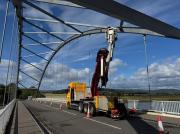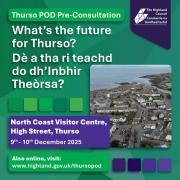Still Time To Apply For The First Decision Making Round Of The 2023/24 Nature Restoration Fund
19th September 2023
The Highland Council have extended the deadline for applicants to apply for the first decision making round of the 2023/24 allocation of Nature Restoration Funding by 12 noon, Wednesday 4 October 2023.
Chair of the Council's Environment and Infrastructure Committee, Cllr Ken Gowans said: "Eligible applicants can apply between £2,000 - £25,000 towards nature restoration projects. Over the last two years, 50 projects have been delivered throughout Highland ranging from the creation of wildflower meadows, tree planting initiatives, wetland creation and removal of invasive non-native species."
He added: "We have extended the deadline to 12 noon Wednesday 4 October to ensure that as many applicants come forward with their project ideas. We have taken a slightly different approach this year in making the fund more flexible for applicants. Applicants are only required to complete the application form and provide some supporting documentation. Please refer to the website for key dates but there will be three decision making rounds in which applicants can apply for funding. This extension is to apply for the first decision making round which will be the end of October. The deadline to apply to the second decision making round will be 30 October for a decision around December."
Established by the Scottish Government, the Nature Restoration Fund (NRF) is a capital fund designed to help support projects that will deliver nature restoration, safeguard wildlife, and tackle the causes of biodiversity loss due to climate change.
Now in its third year, there is a commitment in the current Programme for Government for a multi-year fund to specifically fund nature restoration projects. Most of the allocation is distributed by NatureScot delivered through the ‘Helping Nature' and ‘Transforming Nature’ competitive funding streams. A direct allocation is also awarded to local authorities and national parks to deliver local projects.
The eligibility of the fund is broadly the same as previous years where there is a focus on outcomes which address the main drivers of the decline in biodiversity on land and sea. To deliver this aim, the fund has five strategic themes:
Habitat and species restoration - management for enhancement and connectivity.
Freshwater restoration - including restoration of natural flows in rural catchments.
Coastal and marine - initiatives which promote restoration recovery, enhancement or resilience.
Control of invasive non-native species (INNS) - impacting on nature
Urban - enhancing and connecting nature across, and between, towns and cities.
Although not exclusively, this year there is a particular focus on establishing ‘Nature Networks’ to better connect areas for nature. Also known as ecological connectivity, it is provided by wildlife sites, corridors and stepping-stones, landscape features, watercourses, green and blue spaces that together form integrated ‘Nature Networks’.
Capital items that could form that basis for spend may include, but are not limited to:
Action for pollinators (equipment for maintaining and creating wildflower areas or verges including planting)
Improving condition and use of Local Nature Reserves (purchase and planting).
Developing a local ‘Nature Network’ through planting of wildlife corridors, removal of barriers to wildlife movement and pollinator planting.
Greening active travel routes (creating wildflower areas or verges including planting).
Natural flood management actions such as connecting rivers with flood plains, pond or wetland creation, de-culverting, in-stream works for habitat and flow variability.
Removal of invasive non-native species (INNS) to improve the biodiversity value of the remaining habitat. INNS removal projects must be sustainable beyond the funding period and that there is a plan in place to manage sites thereafter.
Habitat and species enhancement works using native stock, enhancing natural coastal defences through marram, addressing coastal squeeze.
All projects should be completed by the end of June 2024.
The minimum grant support available is £2,000 and the maximum is £25,000.
Applications are welcomed from constituted community groups; public sector bodies; charities; voluntary and social enterprises; co-operatives and community ownership initiatives; development trusts.
Applicants are reminded to read all the information on the website and guidance notes particularly around the Fair Work First requirements. Fair Work First is the Scottish Government's policy for driving high quality and fair work across the labour market in Scotland. This is increasingly being implemented to grants, other funding and contracts being awarded across the public sector. All applicants must provide a signed statement to evidence that their organisation is committed to advancing the ‘Real Living Wage’ and ‘Effective Voice’ criteria. Applications cannot progress without a signed statement.
For full information and further guidance please visit –www.highland.gov.uk/naturerestorationfund
Related Businesses
Related Articles
Exciting Career Opportunities With The Highland Council Now Open For Applications
# 10 December 2025 Career opportunities with The Highland Council The Highland Council is looking to fill a variety of posts relating to civil engineering and flood risk management based in locations across the area. Included are opportunities specifically for civil engineering graduates and technicians, providing the ideal job with career progression for anyone recently qualified and ready for a varied and interesting role.
What the NC500 Research Projects Are Designed to Do - and Why They Matter for the Highlands
As the North Coast 500 approaches its tenth anniversary, it has become one of Scotland's most well-known tourism success stories. The 516-mile loop around the far north of the Highlands has been celebrated internationally, marketed as a world-class road trip, and credited with transforming visitor numbers in some of Scotland’s most remote areas.Help Shape the Future of Thurso
The Highland Council is inviting people that live, work, or study in Thurso, to come along to the public consultation events to have their say. This is an opportunity to help shape the future of Thurso, to gather views and ideas.
Are Scottish Councils Quietly Reversing Outsourcing? A Look at Insourcing, Cuts and the Highland IT Shift
A notable article in the Guardian on 6 December 2025 noted the high sums being paid by London councils outsourcing services to private firms. The article starts with the reduction in council funding by UK government since 2010.Council welcomes Visitor Levy flexibility plan
The Highland Council welcomes moves by the Scottish Government to introduce greater flexibility on how it could design a Visitor Levy Scheme for consultation. The Visitor Levy (Scotland) Act 2024 currently provides local authorities with discretionary powers to implement percentage-based levies following statutory consultation.Highland Council is reaching out for views to shape its next 26/27 budget.
As it looks to set out its forthcoming priorities, the council is seeking involvement from members of the public, including businesses, community groups, parents, and young people. All their opinions are going to be crucial in deciding how Highland Council will take on its budget challenge for 2026-2027.Have your say in Thurso's future £100million investment by attending public consultation events
Thurso is to benefit from £100m investment in education and community facilities and are rolling out the first phase of public consultations on 9 and 10 December 2025. The Highland Council is inviting people that live, work, or study in Thurso, to come along to the public consultation events to have their say; this is an opportunity to help shape the future of Thurso, to gather views and ideas.Finding new owners for empty homes - Scheme launched to help return more empty homes to active use
A new online portal has been launched to bring empty homeowners together with prospective buyers or developers with the aim of facilitating more properties to be used as homes again. Covering the whole of Scotland, this builds on the success of local pilots, referred to as "matchmaker schemes".Consideration for short term let control area in Skye and Raasay
Steps towards introducing a short term let control area have been considered by Highland Council's Isle of Skye and Raasay area committee. On Monday (1 December 2025) the committee heard evidence to justify the grounds for the introduction of a Short Term Let Control Area covering all or part of Skye and Raasay.Workforce North event spotlights Highland economy
EMPLOYERS and educators from across the Highlands have gathered to hear how a new initiative is aiming to transform the region's economy. Workforce North - A Call to Action brought together business leaders and teachers from primary and secondary schools from across the Highland Council area with a wide range of partners geared towards education, learning and skills development at Strathpeffer Pavillion.
